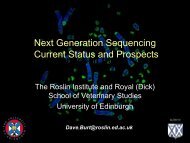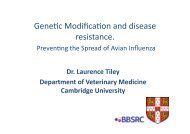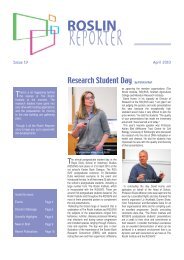Woolliams, John - The Roslin Institute - University of Edinburgh
Woolliams, John - The Roslin Institute - University of Edinburgh
Woolliams, John - The Roslin Institute - University of Edinburgh
You also want an ePaper? Increase the reach of your titles
YUMPU automatically turns print PDFs into web optimized ePapers that Google loves.
Prospects & Progress:<br />
Challenges for the Future<br />
<strong>John</strong> <strong>Woolliams</strong><br />
<strong>The</strong> <strong>Roslin</strong> <strong>Institute</strong> & R(D)SVS<br />
<strong>University</strong> <strong>of</strong> <strong>Edinburgh</strong>, U.K.
Introduction<br />
What may technology <strong>of</strong>fer
One Vision <strong>of</strong> the Future<br />
• Clone-tested on 5 farm types<br />
» most suited to farm type ‘C’<br />
• Carries udder health transgene<br />
• Naturally resistant to bTB<br />
• Category ‘A’ environmental impact<br />
» very low methane per kg milk<br />
• Information provided<br />
» optimum feeding pr<strong>of</strong>ile<br />
» predicted sensitivities to suboptimal<br />
conditions<br />
» genetic & breeding merit for 30<br />
trait with accuracy > 0.9<br />
• Chris Warkup<br />
• Nextgen Daisy
Issues<br />
• Cloning<br />
• Transgenics<br />
• Disease Resistance<br />
• Genotype x Environment Interaction<br />
• Detailed Breeding Information<br />
• Complex Breeding Objectives
Issues<br />
• Cloning<br />
• Transgenics<br />
<br />
<br />
• Disease Resistance<br />
<br />
• Genotype x Environment Interaction<br />
• Detailed Breeding Information<br />
• Complex Breeding Objectives
Precision Animal Breeding
Precision Animal Breeding<br />
• Relevant to<br />
» breeding for products and services<br />
» medical & scientific research<br />
» conservation<br />
» leisure and recreation
Precision Breeding Goals<br />
• To increase the scope and precision <strong>of</strong> predictions <strong>of</strong> the<br />
outcomes <strong>of</strong> breeding<br />
• To avoid the introduction and advance <strong>of</strong> characteristics<br />
deleterious to animal well-being or, more generally, the wellbeing<br />
<strong>of</strong> the species<br />
• To manage genetic resources and diversity between and<br />
within populations in accordance with the principles set out in<br />
the Convention on Biological Diversity<br />
Flint & <strong>Woolliams</strong>, 2008, Proc.Roy.Soc.B
Translation to Poultry<br />
• Better precision <strong>of</strong> traits in the broad breeding goal<br />
» improving evaluation methods<br />
» addressing disease traits<br />
» proactively predicting genetic consequences (correlations)<br />
» genotype by environment interactions<br />
» breeding for different (global) environments
Genomic Evaluation & Selection
Dairy Progress<br />
• Going well!<br />
• Accuracy <strong>of</strong> a<br />
newborn > 0.8<br />
» Milk Net Merit<br />
» 2 years ago!<br />
Source:<br />
USDA
Dairy Progress<br />
• However<br />
» easy to identify<br />
genotyping costs<br />
» low risk testing<br />
» good phenotypes<br />
» low Ne!<br />
Many thousands <strong>of</strong> tested &<br />
genotyped bulls<br />
i.e.<br />
high accuracy phenotypes<br />
Source:<br />
USDA
Factors for Accuracy<br />
Phenotypes<br />
Genome Data<br />
Methodology<br />
Accuracy
Factors for Accuracy<br />
Phenotypes<br />
Genetic<br />
Architecture<br />
Genome Data<br />
Heritability<br />
Methodology<br />
Number<br />
Records<br />
Accuracy
Factors for Accuracy<br />
Phenotypes<br />
Genetic<br />
Architecture<br />
Population<br />
Genome<br />
Structure<br />
Genome Data<br />
Heritability<br />
Number<br />
Markers<br />
Methodology<br />
Number<br />
Records<br />
Marker<br />
Selection<br />
Accuracy
Capturing Variance by SNP<br />
• Max accuracy <strong>of</strong> bovine 50k<br />
chip ~ 0.9 for milk yield net merit<br />
» confidence interval up to 0.93<br />
Daetwyler (2009)
Poultry Phenotypes<br />
Phenotypes<br />
• Phenotypes – poultry well-placed (with commitment)<br />
» number records<br />
» heritability<br />
» genetic architecture<br />
<br />
<br />
<br />
» breeding company structure promotes relevant recording in good &<br />
accumulating numbers
Poultry Genotypes<br />
Genotypes<br />
• Genotypes<br />
» marker choice<br />
» SNP polymorphism must be within populations<br />
» layers and broilers e.g. between – breed predictors still poor
Poultry Genotypes<br />
Genotypes<br />
• Genotypes<br />
» marker choice<br />
» number <strong>of</strong> markers<br />
» larger Ne than dairy cattle in some sectors<br />
» marker density scaled by Ne, 50k chip in dairy ~ 100k in broilers
Poultry Genotypes<br />
Genotypes<br />
• Genotypes<br />
» marker choice<br />
» number <strong>of</strong> markers<br />
» population genome structure<br />
» impact <strong>of</strong> the micro-chromosomes
Poultry Genotypes<br />
Genotypes<br />
• Genotypes – problems being overcome for chickens<br />
» marker choice<br />
» number <strong>of</strong> markers<br />
» population genome structure
Poultry Genotypes<br />
Genotypes<br />
• Genotypes – problems being overcome for chickens<br />
» marker choice<br />
» number <strong>of</strong> markers<br />
» population genome structure<br />
<br />
<br />
» current status <strong>of</strong> turkey & duck genomes and SNP discovery well<br />
behind chickens!
Genomic Evaluation<br />
• However may look to accuracy → 0.9+ for new born animals<br />
over time for routinely recorded traits<br />
• Precision in breeding for what we routinely measure<br />
» less conflict between ‘desired’/’most pr<strong>of</strong>itable’ direction <strong>of</strong> gain and<br />
achieved gain<br />
Desired Gain<br />
Egg Number<br />
Egg Number<br />
Achieved Gain<br />
Growth<br />
Growth
Genetic Epidemiology
Precision in Goals<br />
• Disease resistance is an important part <strong>of</strong> the<br />
complex goal<br />
• How well do we address disease traits
Example from Dairy Cattle<br />
• Analysis <strong>of</strong> bovine TB<br />
» large scale field data<br />
» disease occurs in ‘herd size’ epidemics<br />
» record which animals culled for bTB in each herd before<br />
epidemic halted<br />
» phenotype ‘1’ if culled, 0 if survive<br />
» evidence <strong>of</strong> genetic variation in bTB susceptibility<br />
» h 2 = 0.15 on ‘underlying complementary log-log scale’
Gen’ Epi’ Problems (1)<br />
• Bias in estimates<br />
» exposure, sensitivity & specificity <strong>of</strong> diagnosis<br />
• <strong>The</strong>ory to quantify degree <strong>of</strong> bias<br />
» all factors lead to underestimate <strong>of</strong> h 2<br />
» consistently underestimated importance <strong>of</strong> genetics<br />
» e.g. correction for bTB gives h 2 ~ 0.20 to 0.25<br />
Bishop & <strong>Woolliams</strong> (2010)<br />
• More theory to be done<br />
• Better analytical models to correct biases
Gen’ Epi’ Problems (2)<br />
• Incomplete disease models for genetic variance<br />
» ignore infectivity i.e. ‘shedders’<br />
» impact <strong>of</strong> variation in infectivity potentially as large as<br />
variation in susceptibility<br />
» no easy way to capture this variance in genetic models
Gen’ Epi’ Problems (3)<br />
• What does h 2 ~ 0.25 on ‘underlying complementary<br />
log-log scale’ mean to an epidemiologist<br />
» epidemiologists work on ‘SIR’ models<br />
» time-dependent models with very different<br />
parameterisation<br />
• Need to reconcile models
Role <strong>of</strong> Genomics<br />
• Why debate genetic epidemiology in a session on<br />
next generation technology & ‘omics<br />
• Currently, genetics <strong>of</strong> disease relies upon<br />
» repeated challenge testing by breeding companies<br />
» cost<br />
» biosecurity<br />
» welfare <strong>of</strong> birds<br />
» pedigree analysis <strong>of</strong> epidemics<br />
» relies on quality commercial data
Role <strong>of</strong> Genomics<br />
• Genomics releases these<br />
constraints<br />
» can generate progress in<br />
absence <strong>of</strong> epidemic or<br />
routine testing<br />
» retain ‘genomic memory’ <strong>of</strong><br />
desirable disease resistance<br />
Potential<br />
Breeding Pyramid<br />
Progress<br />
Infrequent<br />
challenge test<br />
Dissemination<br />
Genomic<br />
information
Predicting Genetic Correlations
Genotype to Phenotype<br />
Genome<br />
Gene 1<br />
Gene 3<br />
Gene 2<br />
Gene 4<br />
Gene 6<br />
Gene 5<br />
Gene 7<br />
Protein A<br />
Protein B<br />
Protein C<br />
Protein D<br />
Complex D-E<br />
Protein E<br />
Protein F<br />
Protein G<br />
Environment<br />
Metabolite 1<br />
Metabolite 2<br />
Metabolite 3<br />
Metabolite 4<br />
Metabolite 5<br />
Cell<br />
Division<br />
Growth rate<br />
Cell<br />
Growth
Genotype to Phenotype<br />
Genome<br />
Gene 1<br />
Gene 3<br />
Gene 2<br />
Gene 4<br />
Gene 6<br />
Gene 5<br />
Gene 7<br />
Protein A<br />
Protein B<br />
Protein C<br />
Protein D<br />
Complex D-E<br />
Protein E<br />
Protein F<br />
Protein G<br />
Environment<br />
Physiology<br />
Metabolite 1<br />
Metabolite 2<br />
Metabolite 3<br />
Metabolite 4<br />
Metabolite 5<br />
Cell<br />
Division<br />
Growth rate<br />
Cell<br />
Growth
Genotype to Phenotype<br />
Genome<br />
Gene 1<br />
Gene 2<br />
Gene 6<br />
Gene 3<br />
Gene 4<br />
Gene 5<br />
Gene 7<br />
Protein A<br />
Protein B<br />
Protein C<br />
Protein D<br />
Complex D-E<br />
Protein E<br />
Protein F<br />
Protein G<br />
Environment<br />
Physiology<br />
Quantitative Genetics<br />
Metabolite 1<br />
Metabolite 2<br />
Metabolite 3<br />
Metabolite 4<br />
Metabolite 5<br />
Cell<br />
Division<br />
Growth rate<br />
Cell<br />
Growth
Genotype to Phenotype<br />
Genome<br />
Gene 1<br />
Gene 3<br />
Gene 2<br />
Gene 4<br />
Gene 6<br />
Gene 5<br />
Gene 7<br />
Protein A<br />
Protein B<br />
Protein C<br />
Protein D<br />
Complex D-E<br />
Protein E<br />
Protein F<br />
Protein G<br />
Environment<br />
Metabolite 1<br />
Metabolite 2<br />
Metabolite 3<br />
Metabolite 4<br />
Metabolite 5<br />
Cell<br />
Division<br />
Growth rate<br />
Cell<br />
Growth
Genotype to Phenotype<br />
• Gene expression is where physiology, systems<br />
biology and genetics ‘join up’ & communicate<br />
directly
Variation in Expression<br />
• eQTL<br />
» genetic variants affecting<br />
mRNA abundance<br />
» genetical genomics<br />
» Gibbs et al., PLoS Genetics 6<br />
(5): e1000952<br />
» study <strong>of</strong> human brain<br />
» many eQTL
Variation in Expression<br />
• eQTL<br />
» genetic variants affecting<br />
mRNA abundance<br />
» genetical genomics<br />
» Gibbs et al., PLoS Genetics 6<br />
(5): e1000952<br />
» study <strong>of</strong> human brain<br />
» many eQTL<br />
cis<br />
trans
Variation in Expression<br />
• Epigenetic factors regulate expression<br />
» such as methylation (DNA, histone marks)<br />
» ‘switches’ <strong>of</strong> DNA transcription & expression<br />
• Methylation is a very dynamic process<br />
» regulation <strong>of</strong> heat shock in chickens<br />
• Opened up by next generation sequencing
Variation in Expression<br />
• mQTL exist!<br />
» and in abundance<br />
» some loci affect the<br />
methylation state <strong>of</strong> other loci<br />
» Gibbs et al., PLoS Genetics 6<br />
(5): e1000952<br />
» study <strong>of</strong> human brain<br />
» genetical epigenetics<br />
cis<br />
trans
Precision Breeding<br />
• Bioinformatics analysis <strong>of</strong> eQTL & mQTL can begin<br />
to predict genetic correlations<br />
» network building<br />
» pathway analysis
Precision Breeding<br />
• Bioinformatics analysis <strong>of</strong> eQTL & mQTL can begin<br />
to predict genetic correlations<br />
» network building<br />
» pathway analysis<br />
• Specific hypothesis that mQTL may be important to<br />
understand and overcome G x E<br />
» poor regulation <strong>of</strong> ‘production’ loci under challenge<br />
» disease or nutritional challenges
Summary
Summary<br />
• Challenges to deliver Precision Breeding<br />
1. Delivery <strong>of</strong> genomic evaluation<br />
• < 2015<br />
• made feasible by next generation technology<br />
2. Genetic epidemiology, theory and application<br />
• < 2020<br />
• beneficial exploitation requires genomic evaluation +<br />
3. Predicting genetic correlations, including GxE<br />
• < 2025<br />
• requires next generation sequencing





